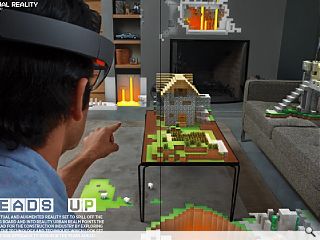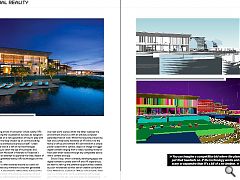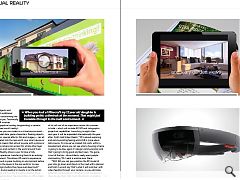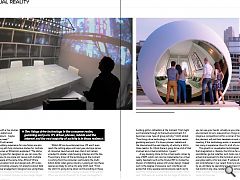Virtual Reality: Heads Up
9 Jul 2015
With virtual and augmented reality set to spill off the drawing board and into reality Urban Realm points the way ahead for the construction industry by exploring some of the technology and techniques which look set to shape our approach to design in the years ahead.
The impending arrival of consumer virtual reality (VR) is reinvigorating the visualisation business as designers get their hands on a new generation of toys to play with but what will the likely impact be on communicating design and the architectural process itself? Urban Realm takes a look at a raft of new technologies are competing to catch the eye of businesses and consumers from Microsoft’s Hololens to Facebook’s Oculus Rift in an attempt to appraise the likely impact of virtual and augmented reality (AR) technologies on the design process.Whilst VR is often bandied around as a catch all term to describe any immersive consumer generated experience it is important to differentiate between the two primary strands of technology available; AR and VR. The former entails layering additional information over real world scenes whilst the latter replaces the environment around us with an entirely computer generated field of view. Whilst the requisite processing heft and cumbersome hardware of VR limits it to the home or office environment AR can transform a simple poster coded with a symbol, object or image to trigger digital content ranging from a video, building model or floor plan when viewed through any compatible device with a camera and app.
Soluis Group, which is already developing apps and digital content to power both AR and VR experiences, are keen to talk-up the potential opportunities created by such innovations as their senior creative consultant Greg Williamson, explained: “Where virtual reality takes you to a whole other world, augmented reality keeps you firmly in this one...but with perks by augmenting real world objects and surfaces with additional information transforming the world around you. Technically speaking, AR involves applying a graphical overlay (augmenting) a camera feed of the real world (reality).
“Whatever you can create in a virtual environment – BIM / 3D model data, game characters, floating objects, video screens, special effects, film and imagery – can all be incorporated into the real world via a smart device or headset. This means that almost anyone with a phone or tablet with a camera can access this whole other layer of information and content in the world around them.
“Virtual Reality allows a user to have a fully immersive experience, transferring them to an entirely new environment. This allows VR users to experience and understand a space, building or environment before they travel to the space in the real world or to view building designs before they have even been built.”
Another studio seeking to muscle in on the action is Pixel Image with founder & creative director Steve Smith evangelical about the possibilities on offer ahead of his roll-out of an experience centre this summer in India – which will include AR/VR and holographic projection capabilities. Launching in eight cities next year it will be expanded internationally the year after. Smith told Urban Realm: “VR is about exploring and communicating feeling whilst AR is more about data source. On site we’ve created hot spots within a development where you can see what a housing scheme is going to be like, again it’s design communication and that’s going to bring good and bad news. The genie is out of the box - do architects really want people commenting ‘Oh I want a window over there.’
“With AR you can geo-position the 3D model of your site, go down and stand on the road with a planner and hold it up and say ‘that’s what it will look like,’ with video feeding through your camera, so you eliminate potential misconceptions. Whether or not the desire is there to give them that much information or whether they’re fine with a few studies, fenestration details and rendering colours - maybe that’s all they need.”
Whilst VR will remain primarily a solitary experience for now Soluis are also experimenting with fully immersive domes for multiple user experiences as Williamson explained: “The dome is particularly good for designers as you can view the design at a one to one scale and review with multiple groups of people at the same time. AR and VR are both communication tools and design aids. AR is also capable of providing uniquely rich analytics about data usage and user engagement. Designers are using these technologies to assess a prototype or the planned construction in context through various design stages.”
Whilst AR can be embraced now, VR won’t even reach the cutting edge until next year during a series of consumer launches and even then it will remain unsuited to smaller scale housing schemes and the like. The primary driver of the technology at the moment is coming from the consumer; particularly the multi-billion dollar video game industry. Looking at how these spaces are likely to come into play Smith said: “From the start it’s going to be about communicating in these virtual spaces but who is going to design those spaces? When you look at Minecraft my 12 year old daughter is building gothic cathedrals at the moment. That might just translate through to the built environment if it becomes a new type of group activity.” Smith added: “Two things drive technology in the consumer realm; gambling and porn. It’s driven phones, tablets and the internet and the vast majority of activity is still in those realms. So I think there is going to be a bit of that involved and virtual prostitution, I guess.”
A key stepping stone to the virtual realm comes by way of BIM, which can now be implemented on virtual reality headsets such as the Oculus Rift to invoke the illusion of inhabiting spaces still under design. Indeed such is the degree of presence such interfaces can evoke that many people subconsciously reach out to touch the intangible environment around them. Smith said: “Software can provide the full range of motion, so you can see your hands virtually as you interact with the environment to turn, poke and turn things on. You can imagine a competition bid for a corner of town where all the planners will put their headsets on and convene the meeting. If the technology works, is accessible and isn’t too scary or expensive, then it’s a bit of a no brainer.”
The growth in visualisation technologies mean that imagination is, literally, the limit as far as design possibilities go but whether such tools can deliver actual improvements to the humdrum environments of everyday reality is far less clear. If uptake of the internet and smartphones in our recent history is anything to go by we will likely be spending less and less time in the real world in any case, rendering such concerns moot. What is certain is that virtual reality is about to get a whole lot more real.
|
|
Read next: Linwood: Park Life
Read previous: St Peter's: Seminal Seminary
Back to July 2015
Browse Features Archive
Search
News
For more news from the industry visit our News section.
Features & Reports
For more information from the industry visit our Features & Reports section.






